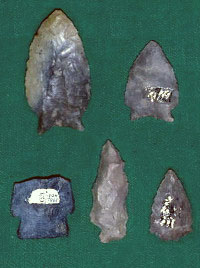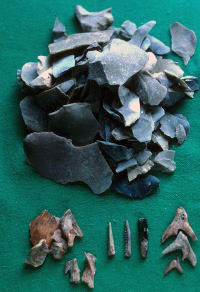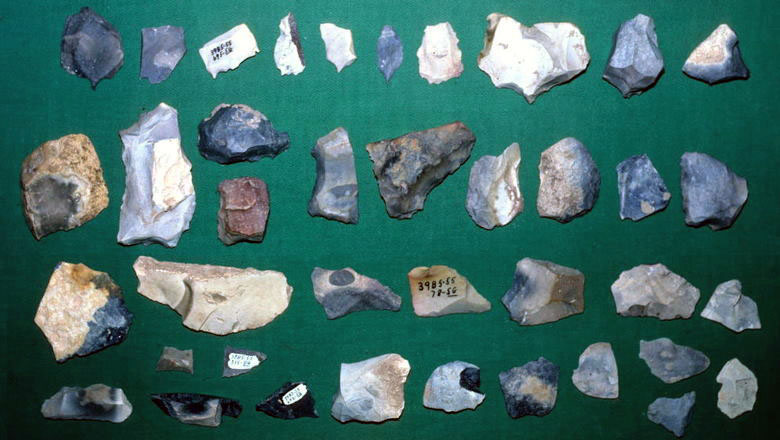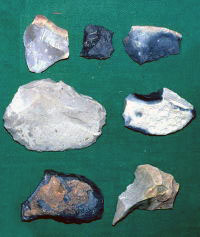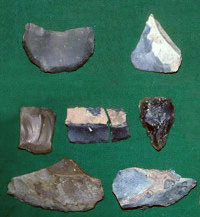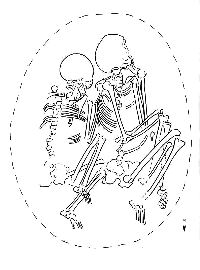
Plan map of double grave. See the section, A Paleoindian Grave , for more detail. Drawing by Frank Weir. |
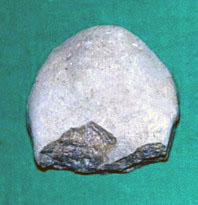
|
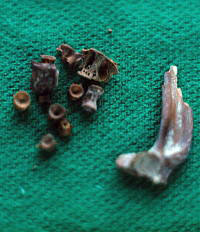
|
Sub-Stratum 5G: Upper member—heavy gray
Substratum 5G is a very dark, midden-like cave deposit, which has been considerably dirtied by human living. Its interface with the underlying Sub-Stratum 5F is indistinct, distinguished chiefly by darker gray color.
Of particular significance in Sub-Stratum 5G was the discovery of the double grave of an adult male and a juvenile. The two had been interred with an array of unusual items in a relatively shallow pit that extended or had been dug in from this surface into the underlying deposits. At the time of investigations, the top of the grave was not detected by excavators. Details about this important feature are presented in the section, A Paleoindian Grave.
This layer represents the heaviest occupation in the Paleoindian levels of the shelter, containing large amounts of chipped-stone tools, including fluted points termed "Brazos Fishtail," animal bone and other debris, and several fire hearths.
Overall, the comparatively greater quantity of tools and other debris found in this stratum may indicate either a longer stay or successive occupations by people, rather than a larger number of people overall, given the small size of the shelter.
This sub-stratum has four radiocarbon dates from samples taken at the time of excavations, two from charcoal and two from snail shell. Two different dating agents were used as a cross check. The dates are as follows: 9500 +/- 130 years B.P. (Tx-1830 wood charcoal); 10,030+/- 130 years b.P. (Tx-1998 snail shells); 9980 +/- 370 years B.P (Tx-1722 wood charcoal); 10,310 +/- 150 years B.P (Tx-1997 snail shells).
Two additional dates, obtained by the Smithsonian Institution on fragments of human skeletal bone from the Horn Shelter burial are in close correspondence to the assays reported earlier: uncalibrated AMS date for the adult is reported as 9710+/-40 years B.P. (CAMS-60681); for the juvenile, 9690+/-50 years B.P. (CAMS-51794).
Although there were a number of hearth features in this stratum, some may have been disturbed by successive activities of the occupants over a period of time. Overall, the hearth features were typical of the other Paleoindian levels: areas of dark or charcoal-stained soil where the inhabitants had made fires directly on the ground, without the use of rocks. More than 70 pounds of soil from the features was screened and washed, and a quantity of small animal bones and flint debris from toolmaking recovered.
Other than the materials found within the grave, the Sub-Stratum 5G assemblage includes a large number of stone tools and fragments including projectile points, bifaces, drills, gravers, unifaces, quartzite choppers, burins, utilized flakes, hammerstones, and debitage. Red ocher fragments also were present. A large quantity of animal bone was recovered, some of it worked, crushed, and/or burned. Remains of small mammals were the most prevalent including rabbits, voles, rodents, birds, frogs, turtles, snakes, fish, and freshwater mussels. Deer and a few bison bones also were recovered.
Projectile points include two points termed "Brazos Fishtail,"possibly a variant of San Patrice; the base of probable Wilson (which refits with the distal portion found in the underlying Sub-Stratum 5F); and two unclassified points. One of these likely is a Brazos, or San Patrice, blade section, the other is a heavily resharpened side-notched point with concave base. The latter specimen (see artifact plate at top left) has been heavily beveled along both blade margins, apparently having been recycled for use as a scraper-tool. Archeologist Dee Ann Story notes that this specimen exhibits technological similarities to Albany knives and "spokeshaves" found in sites with San Patrice dart points in East Texas and Louisiana.
Basal grinding on the "Brazos Fishtail" points is more pronounced along the tang lateral edges, but ranging from moderate to almost none on the basal concavity. Fluting is accomplished by the removal from both sides of several long narrow longitudinal flakes; on one, fluting extends half the total length of the point. This point appears similar to the "Side-Hollowed" points from the Rex Rogers site in the Texas Panhandle and the Green type from Florida, both of Paleoindian age.
Among the tools, gravers are often multiple pointed and frequently made on one end or side of a scraper. The tips are generally short and strong. Drills are large and heavy though very finely made, except one specimen that has a thick, almost round, cross section. The proximal ends are broken from the other two large specimens. Neither appears to have been made on broken darts or knives.
Radiocarbon dates:
Diagnostic Points:
|
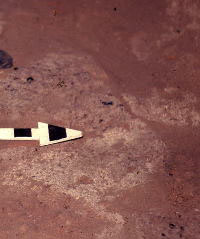
|
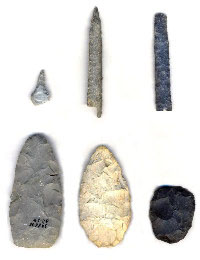
|
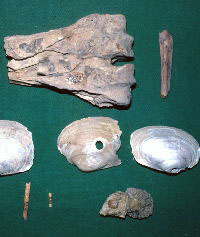
|
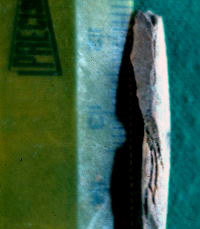
|
